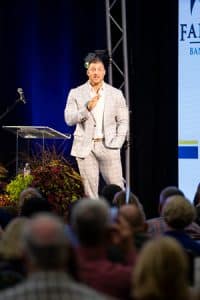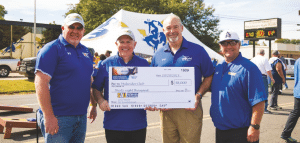Love of country and a desire to help his fellow Americans battle a new enemy, coronavirus, led Ray Burns, a World War II veteran, Columbia County native and former student at Magnolia A&M, to walk to raise money for virus relief. Born on Aug. 5, 1920, Burns walked 100km – or about 62 miles – in celebration of his upcoming 100th birthday to raise money for healthcare workers battling the COVID-19 pandemic. He finished his challenge six weeks ahead of schedule joined with family and friends by his side for his last mile. His fundraiser is still active. Anyone wishing to help Burns may visit his website PapaRayWalks100 that links to his GoFundMe campaigns.
“Every morning at 9:00 a.m., there is at least one or more of my neighbors waiting at my steps,” Burns said. “I never realized how valuable it would be for me to really get to know all of my neighbors and friends. I tried to cover about 2 kilometers a day. I had a mission in the morning and in the afternoon. My son is a walker/runner, and he measured out several routes that cover 1 to 1.5 kilometers, so I could pick the one I wanted.”
He was inspired by British WWII veteran Tom Moore, who raised millions by starting a program of walking in his garden. Burns set a goal of raising $15,000; to date, he has raised more than $14,800 towards his goal. “We have to work together to save our country,” Burns said. “I would like to complete this mission.”
Born and raised in Walkerville, a small farming community between Taylor and Emerson, Burns still feels affection for Columbia County. He attended SAU in 1940 when it was known as Magnolia A&M. In 2009, he established a nursing endowment in memory of his late wife, Emogene Winn Burns, also from Walkerville, and late daughter, Suzanne Harvey, who was a nurse. That year, he attended the Great Southern Arkansas Mule Ride, which allowed mule or wagon rides to celebrate SAU’s Centennial. “I graduated high school in 1940 and enrolled in Magnolia A&M,” he said. “My plans were to become a Soil Conservation Engineer as my oldest brother had done. I joined the Arkansas National Guard, Company B, 153rd Infantry Regiment, not with the intention of making a career, but to serve my country and help finance my college education.”
By mid-1940, the German Army was preparing to invade Britain. “It was very obvious the U.S. would be compelled to defend Britain, though most Americans were opposed to entering the war,” Burns explained. “President Roosevelt called National Guard units to active duty for one year, and the 153rd Infantry Regiment was selected. We were mobilized in December 1940.” The regiment completed combat training in Tennessee, then boarded a troop train for Seattle, Washington. “About August or September, the U.S.S. Grant pulled in, and we headed west on the troop ship. Rumor was we were going to the Philippines, but after six days, we wound up in a fishing village in Alaska. We performed Guard duty there for the construction of an air base.”
Burns was in Alaska when Pearl Harbor was attacked by the Japanese on Dec. 7, 1941. “Our mission changed significantly from construction to defending what we had,” he said. “We were trying to defend the place with Company B from Magnolia. The biggest weapon we had was a .30-caliber machine-gun.” The mission was completed in 1944. “We headed back home. After arriving at Camp Shelby, Mississippi, we were given a 15-day leave and informed we would receive six weeks of refresher training before being sent to Europe as replacements – this was the time of the D-Day invasion.”
Three weeks into training, orders changed, and the regiment was deactivated, its personnel sent to training centers in Florida, Texas and Arkansas. “I was sent to Fort Hood and remained there until the war ended in Europe. I volunteered for paratroop training but was denied due to the critical mission we were performing. The U.S. had about 15 million men and women in service and began releasing some on a point system.” Burns was released in July 1945. He intended to return to A&M but took an interim job with Halliburton Oil Well Servicing Company. After the war with Japan, job situations changed, and Burns was required to move. Meanwhile, he and Jean had married and started a family. “I decided to go back into the service, in the Army Air Corps,” Burns said. He served in the Air Force until 1969, a period that saw the U.S. enter the Korean War, the Vietnam War, and the Cold War. He worked on various radar, electronics, ballistic missile, and space launch projects during his career. After retiring from the Air Force, he accepted a position with Lockheed- Martin, retiring from the company in 1986. “I had a great life,” he said. “I don’t get back to Mulerider Land as often as I would like, but Dr. Trey Berry keeps me informed. I am so proud of what the University has accomplished. It’s a great school; a lot of people like myself would not have been able to go to school without SAU or Magnolia A&M.”
He said the money he is raising is “for the ones putting their lives on the line every day. That’s what motivates us.” Funds benefit the Mile High United Way COVID Relief, Operation USA, and Feeding America, all of which support medical, emergency response and delivery efforts affected by COVID-19.




